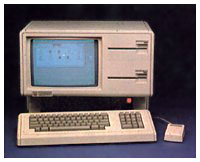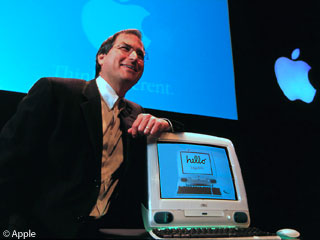Mac Musings
Steve Jobs, the Wow Factor, and Apple's Stellar Growth
Daniel Knight - 2011.03.09 -
Follow Low End Mac's blogs: LEMblog and Low End Mac Services.
Apple really does Think Different. Innovation is in its DNA, and it markets its hardware based on what it does, not on raw specifications.
Wow, Color!
This all began with the Apple II in 1977. It was the first personal computer to support color graphics (the Apple I was more of a hobbyist computer - it didn't include a case, keyboard, or power supply). Color support was a clever hack, and Steve Wozniak used the same kind of different, outside the box thinking in developing a floppy drive for the Apple II that was far more affordable than the competition had.
Wow, an Electronic Spreadsheet!
The Apple II had expansion slots, built-in sound, and a decent keyboard, but the thing that gave it a leg up on the competition in the business world was VisiCalc, the world's first electronic spreadsheet, which was launched in 1979. Versions were later released for the TRS-80, Commodore PET, and Atari 800, but Apple had it first. (Ironically, it was another spreadsheet program, Lotus 1-2-3, introduced in 1983, that helped establish IBM PCs as the standard in the workplace.)
Businessmen would buy an Apple II and VisiCalc so they could create their own spreadsheets and do their own "what if" calculations, saving countless hours with a calculator or waiting for the IT department to crunch numbers on the corporate minicomputer or mainframe.
There were also word processing and database programs, but it was VisiCalc that made Apple a leader in the 8-bit era.
Wow, a Graphical Interface!
 Although the graphical user
interface (GUI) had been developed at Xerox PARC, nothing was done with
it outside the lab until
Apple saw it. Apple licensed the technology and incorporated it in
Lisa, its 1983 answer to
the IBM PC. When it was introduced, Lisa wowed the tech world.
Although the graphical user
interface (GUI) had been developed at Xerox PARC, nothing was done with
it outside the lab until
Apple saw it. Apple licensed the technology and incorporated it in
Lisa, its 1983 answer to
the IBM PC. When it was introduced, Lisa wowed the tech world.
However, it's $10,000 price tag made it a nonstarter for most businesses. Nice as it was to be able to use different typefaces and font sizes and create images, it wasn't enough, and the innovative Lisa became an interesting footnote in personal computing history.
Wow, the Macintosh!
Steve Jobs pulled out all the stops when Apple introduced the Macintosh a year later. While the consumer version of the Mac had only 128 KB of system memory (21 KB of that used by the display), Jobs had a special 512 KB version built for the demo. At the demo, Jobs took the Mac from its carrying case, plugged it in, and had it display a "hello" screen and begin to talk. The tech press went gaga!
Best of all, at $2,495, the Mac was far more affordable
than the Lisa, and Apple sold over 50,000 in the Mac's first three
months on the market. Why? Because Apple had attracted the attention of
geeks with its demo and priced the Mac affordably at $1,500 less than the IBM AT.
The Macintosh also had Microsoft MultiPlan, a graphical spreadsheet program designed to take on Lotus 1-2-3, which dominated the PC world but wasn't released for the Mac until 1991. In 1985, MultiPlan gave way to Excel, with remains the standard in spreadsheets to this day.
Later in 1984, Apple introduced the 512 KB Fat Mac, which paved the way for desktop publishing.
Wow, Desktop Publishing!
Just as VisiCalc had brought Apples into the workplace, in 1985 desktop publishing gave the Mac its first niche. Thanks to two developments - the laser printer and Aldus PageMaker - Apple took the graphical advantage it had in word processing, drawing, and image editing and leveraged it.
The first LaserWriter printer was a big, heavy, expensive beast, but its Postscript support and 300 dot-per-inch resolution made it a great tool for creating flyers and proofing content that would later be professionally typeset. At $6,995, it's a good thing the LaserWriter was networkable, allowing several Mac users to share the same printer over a simple network.
PageMaker let you take your Microsoft Word (new to the Mac in 1985) documents and MacPaint images and turn them into real page designs.
Less Wows: 1986 to 1996
The Mac Plus didn't really bring much new to the Mac. It was mostly incremental improvements - more memory, expandable memory, double-sided floppies, and a new keyboard with arrow keys and a numeric keypad. The only new technology was SCSI, an interface that made it easy to add high-speed (for 1986) external hard drives and other peripherals.
More memory and fast hard drives made it a better desktop publishing machine, and improved LaserWriters printed faster, but it was mostly incremental improvement.
Why no wow? Because Steve Jobs had been eased out of Apple in late 1985. Apple's new management understood the Macintosh - hardware, software, operating system, and peripherals - but it didn't know how to wow the tech press.
The Mac II brought color to the Mac in 1987 in a big way, but IBM's PS/2 line brought 256-color displays to the PC world. Outside of the graphics community, most of the business world remained wed to the PC standard - as it still does.
During the decade without Jobs, Apple created some of its least memorable projects and most poorly designed Macs. Remember the Performa and Centris brands? What about the deliberately crippled LC, Color Classic, and Performa 5200?
Apple had lost its focus and nearly killed itself when it decided to allow licensed Mac clones and its competitors began to offer more powerful top-end hardware that ate away at Apple's most profitable lines. Apple's attempts to create a next generation operating system were going nowhere, so the company decided to look outside and acquire an existing OS as the basis for the future Mac operating system.
Wow, Jobs Is Back!
Apple acquired NeXT, which Steve Jobs had founded after leaving Apple, and its NeXTstep operating system would become the basis of Mac OS X, the next generation OS that Apple finally launched ten years ago in March 2001.
Jobs slowly built his power base at Apple and eventually retook the reins he had given up when he hired John Sculley to run Apple.
 Wow, the iMac!
Wow, the iMac!
The first thing Jobs did was create a skunkworks project to develop a new Macintosh computer that would put the focus back on Apple. That team developed the iMac, which was announced on May 6, 1998 but didn't reach dealers until August 15. That gave the industry three months to debate the pros and cons of the iMac - and the fledgling Mac Web to fan the flames. The iMac launched with a bang with some stored opening at midnight so their customers could buy the new Mac as soon as Apple allowed.
Wow! Wow! Wow!
Since then, Jobs has used the Wow Factor to great effect. Apple began 1999 with a new Power Mac G3 design as brightly colored as the iMac. In July 1998 he announced the iMac-inspired clamshell iBook, giving the tech world nearly two months to prepare for its release.
At the end of August 1999, Steve Jobs unveiled the Power Mac G4, which was so powerful that the US government classified it as munitions, preventing its export to certain nations. Apple made the most of that supercomputer label!
In 2001, Apple introduced Mac OS X and the iPod. OS X was a visual treat but had very little software. Fortunately Apple had the foresight to develop Classic Mode, which allowed users to run old Mac apps within OS X - a feature it lost with the introduction of OS X 10.5 Leopard in 2007. And OS X lost the ability to run PowerPC applications when OS X 10.7 Lion shipped.
The iPod brought Apple into a whole new consumer electronics market, and it made a huge splash despite the fact that the original iPod was a Mac-only device. Later versions added PC support but still required FireWire, and still later Apple moved the iPod to USB 2.0. The iPod has shaped the entire MP3 player industry - and dominated it.
In June 2005, Steve Jobs announced something unthinkable to many Mac loyalists - sometime in 2006, Apple would move the Macintosh to Intel x86 CPUs. After over a decade extolling the virtues of PowerPC chips over Intel x86 CPUs, we were shocked, to say the least.
Between January and August 2006, Apple migrated its entire line to Intel CPUs, and geeks quickly found ways to install and run Windows on these Intel-based Macs. Apple eventually acquiesced and made Boot Camp part of OS X, allowing users to choose between Windows and OS X at startup. Other companies found ways to virtualize Windows (and Linux) and run it alongside OS X.
Needless to say, Windows users could now go Mac without losing their familiar OS or apps that had no Mac equivalent. Mac market share has been climbing steadily ever since.
In 2007, Jobs announced the iPhone in January, but it didn't ship until midyear, allowing the tech press to speculate and built interest. The original iPhone was a closed platform, and developers wanted to create software for the new platform. Apple announced the App Store in March 2008 and launched it in July 2008 along with the iPhone 3G.
The original iPhone operating system did not support multitasking, which the tech press clamored for, and Apple added it with iOS 4. (iOS was the new name for the iPhone operating system in light of it also working on the iPod touch and, later, the iPad, and, even later, Apple TV.)
In 2008, Apple launched an extremely thin and light notebook computer, the MacBook Air, to address those who wanted or needed a thinner, lighter MacBook and didn't want to use a cheap, underpowered netbook. When one tech writer accidentally threw out his MacBook with the trash, Apple got a lot of free publicity.
The iPad was another wow event, and it's now clear that this is the Steve Jobs secret ingredient that first made Apple successful and made it even more successful since his second coming. (See Trust by alx, which inspired me to write this column, for more on this subject.)
Apple is what it is today not because of great hardware, great operating systems, or great software. Apple is what it is today because it can show the world something new that can do things they may never have thought of or have only dreamt of.
From those crude 4-color games on the Apple II to the graphical innovation of MacWrite and MacPaint to the power of iMovie, iTunes, iPhoto, Garage Band, iWeb, and iOS apps, Apple has given us solutions, not just computers.
Join us on Facebook, follow us on Twitter or Google+, or subscribe to our RSS news feed
Dan Knight has been using Macs since 1986, sold Macs for several years, supported them for many more years, and has been publishing Low End Mac since April 1997. If you find Dan's articles helpful, please consider making a donation to his tip jar.
Links for the Day
- Mac of the Day: 14" 600 MHz iBook G3, introduced 2002.01.07. The first 14" iBook ran at a comfortable 600 MHz.
- Support Low End Mac